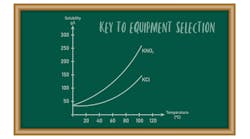Powder Handling: Identify Key Experiments For Solids Scale-Up
Solids are the most common form of product manufactured, primarily because they are easy to store and transport. However, designing a process involving solids can drive you crazy. Unlike liquid products, solids can separate or agglomerate, altering the solubility, color and density, among other things. It becomes important to identify vital experiments for process scale-up and design. It’s a roadmap that should be followed, even when the overall process looks straightforward.
Designing a process involving solids can drive you crazy.
I’ve been in many meetings where we were in production only to discover an unexpected physical characteristic of our product. In pharmaceuticals, the most common is polymorphism. In one particular case, we were well ahead of our competitors on a new drug when we discovered a polymorph. This wasn’t news to the chemists, because one person in the development group had seen behavior that would suggest a polymorph. Had the team used a roadmap to develop the process, future work on drying and crystallization probably would have discovered that process problem before it became a problem. Here is the roadmap I suggest:
- Define the required product properties. This includes particle size distribution and solubility. Marketing and/or sales often express an interest in modifying a current product. You need to pin them down on all the product characteristics. For example, based on discussions with the customer, they may feel a coarser particle would have a distinct advantage over the current powder. However, the packaging, rate of dissolution and solubility will probably change.
- Identify polymorphs and solvates. You need to look very hard to find these characteristics. Fortunately, several chemical modeling programs allow you to simulate behavior and the potential for a structure to misbehave. In the example given above, we were able to simulate six polymorphs. The one causing the problem was unstable, but it was stable long enough to produce undesirable agglomeration. In another case, we found the desired product was one of the unstable polymorphs that could command a premium price over the mixture of polymorphs.
- Establish the basic process route and evaluate alternatives. For example, a coarse particle may be desirable because it can reduce dustiness. If the first step in the process is crystallization, there are several routes to making the coarse particles. The crystals can be grown to the desired size using seeds or specialized crystallizers (a draft tube is a common choice). This makes for a simple process but can involve expensive equipment and more time than what would take to make a smaller particle, which could be washed and dried in a fluid-bed granulator to make the larger particle. A variation would be to dry the finer particles in a rotary or drum drier. Then, in a separate agglomerator (think pan dryer or Marumerizer) make the larger particle. These are often stronger than what you get from a fluid bed. As you can imagine, there is a wide range of costs with each of these processes. In addition, the strength of the particles and size distribution can vary. However, not evaluating these alternatives can be costly.
- Investigate temperature sensitivity. Most particulate solids must be dried. This is especially true for organic chemicals, as heat flux can change the structure (i.e. isomers). It doesn’t have to be a dryer that causes this change. For example, we had an organic with several polymorphs. The process ran[?] for several years and consistently produced the most stable polymorph. One day, a batch of product came out with the wrong polymorph, and it occurred two to three times a week. It turns out the solubility curve of the unstable and stable polymorph crossed each other. A change in heat flux allowed the crystallization to start at a higher temperature, producing the unstable product, which continued to grow as the temperature fell.
- Obtain basic data on filtration and settling rates. Develop solubility and drying curves. I’ve mentioned the importance of these curves in design, and especially in diagnosing operating problems. Often, someone has had a good experience with a specific piece of equipment, but it’s even better to have experimental data to back up that choice. In the previous example, the plant only had the solubility curve for the most stable polymorph. Surprisingly, they went many years without experiencing a problem.
Don’t go blind into your next process design; follow the roadmap to success.



